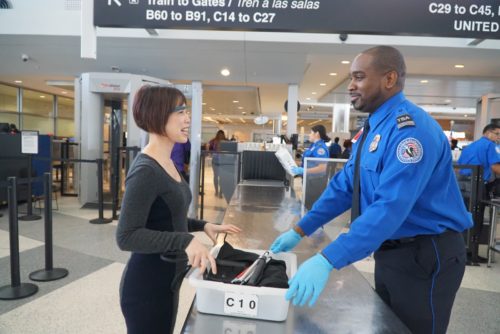
Courtesy AIRA
My ‘At the Airport’ column on USA TODAY this month is about Aira, a new service that makes airports more accessible to people who are blind or have low vision. Here’s a slightly edited version of that column.
Airports around the country are beginning to offer travelers an augmented reality service that uses Google glass-style technology or a smartphone app to offer greater mobility and independence to blind passengers and those with low vision.
And, for now, airports offering the service are doing so for free.
How it works: off-site eyes
San Diego-based Aira offers a paid subscription service that provides blind and low vision customers smart glasses and smartphone software that connectsto remote live agents who use the cameras on the glasses or the smartphone to see what’s around the user and offer guidance.
Subscribers (Aira calls them ‘explorers’) can call on a remote agent to have them help with anything from tasks in the home, grocery shopping or traveling around the world.
“I’ve had help identifying receipts and papers on my desk, identifying the colors of things in my wardrobe and reading labels on spices if I’ve been smelling too many spices and my nose is tired, ” said Christine Ha, an Aira advisory board member.
Ha has also used the Aira service at Houston’s George Bush Intercontinental which, along with Houston Hobby, Memphis International, Minneapolis-St. Paul International, Seattle-Tacoma International, Spokane International and (soon) others, picks up the per-minute costs associated with using the Aira app or subscription service in the terminals.
“Many, but not all, airport employees are well trained to help people with vision impairments,” said Ha “But I like to be independent and find that Aira agents can pull up airport maps and serve as a virtual concierge, talking in my ear and describing what’s around,” including shops and restaurants, restrooms, gate hold areas and art.
The Aira service was not specifically designed for use in airports, but users been telling the company how their experience at airports has been transformed.
“We learned that at airports, visually impaired travelers often have to call ahead for assistance and might be met at the curb by someone who puts them in a wheelchair and just delivers them to their gate,” said Kevin Phelan, Aira’s Aviation Lead and head of Sales. “This service allows users to be independent and enjoy the airport like everyone else. So, we’ve been meeting with airports to let them know this service exists.”
Airports adopt Aira
Airports offering the Aira service for free see it as a customer service.
The Houston Airport System, which operates Hobby Airport and George Bush Intercontinental, chose to participate as part of its goal “To be a role-model of accessibility for all travelers and to make the airport experience as memorable as possible,” said Tim Joniec, the airports’ Americans with Disabilities Act Coordinator.
At Minneapolis-St. Paul International Airport, spokesman Patrick Hogan said providing the Aira service for free at the airport was a “no brainer,” because “It’s a great way to ensure people with little or no vision can enjoy the same airport experiences that sighted people do.”
Memphis International Airport, the first to adopt Aira, is pleased other airports are following its lead in offering the service to passengers. “This shows a collective commitment in the airport industry to ensure greater accessibility and convenience for all passengers,” said MEM spokesman Glen Thomas.
While some airports have found out about AIRA by word of mouth, others are learning about this and other useful services through a matchmaker-type program for airports and start-ups.
“We recognize airport leaders are very busy and don’t have the wherewithal to scout the startup community for solutions,” said Chris Runde, director of the Airport Innovation Accelerator at the American Association of Airport Executives, “We try to bridge the gap by finding out what airports need and then finding what’s out in the marketplace.”
In addition to helping the Aira team understand how airports work and making introductions for them in the airport community, AAAE’s accelerator program is also making airport connections for several other groups, including Elerts, which offers See Something Say Something mobile apps that can help improve airport safety, and Sleepbox, a micro-hotel company that just signed a contract to place 16 units at Dulles International Airport.
Thanks for visiting Stuck at the Airport. Subscribe to get daily travel tidbits. And follow me on Twitter at @hbaskas and Instagram.
Loved seeing this product in general, not just for air travel. Thanks!